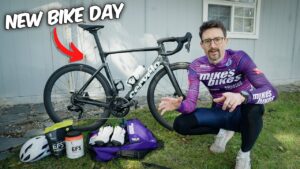Can 2 Roadies Beat 1 Time Trialist? | NorCal Cycling
Source: NorCal Cycling Youtube Channel: Can 2 Roadies Beat 1 Time Trialist?
Video Can 2 Roadies Beat 1 Time Trialist? with NorCal Cycling
Video Can 2 Roadies Beat 1 Time Trialist? with NorCal Cycling YouTube Channel.
Can 2 Roadies Beat 1 Time Trialist?
NorCal Cycling: How to Optimize Aerodynamics and Equipment for Maximum Performance
When it comes to cycling, every advantage counts, and one of the most significant advantages a cyclist can have is an optimized position and equipment. In this article, we’ll explore the concept of optimizing aerodynamics and equipment to achieve maximum performance in cycling, as demonstrated by a real-world experiment conducted by a group of cyclists.
The Experiment: Can an Aggressive Road Bike Position Match the Performance of a Time Trial Bike?
In a YouTube video, a group of cyclists set out to answer the question – can an aggressive position on a road bike match the performance of a dedicated time trial bike? The experiment involved testing the performance of both types of bikes on a known course, with the aim of determining whether an aggressive position on a road bike could close the gap in performance compared to a time trial bike.
The Bikes: A Comparison of Aerodynamic Design
The video showcases the comparison of two bikes – a road bike and a time trial bike. The road bike, a Scott, is described as an “aero machine,” but pales in comparison to the “rocket ship” time trial bike. The visual demonstration of the two bikes highlights the sleek, aerodynamic design of the time trial bike, raising questions about whether a road bike can achieve similar performance.
The Tests: Running Multiple Experiments to Compare Performance
The cyclists conducted several tests on the known course to determine the performance of the two bikes. The tests involved a comparison of power output, speed, and aerodynamics, with the primary goal of evaluating whether the road bike could match the performance of the time trial bike in an aggressive position.
The Results: Analyzing the Data and Key Findings
After conducting the tests and analyzing the data, the results revealed that the time trial bike outperformed the road bike by 1.3%. However, the gap was significantly narrowed when the cyclists adopted an aggressive position on the road bike. Moreover, the time trial bike demonstrated a 4.4% advantage on a downhill section of the course, emphasizing the role of speed and aerodynamics in bike performance.
The Role of Drafting: Leveraging Aerodynamics for Racing Success
The pivotal role of drafting in racing success was highlighted, with the cyclists emphasizing the importance of positioning oneself in a group. The experiment provided valuable insights into the impact of positioning and drafting on overall performance, shedding light on the advantages of leveraging aerodynamics in competitive cycling.
Equipment Optimization: Choosing the Right Bike for the Terrain
The experiment also raised questions about the suitability of a time trial bike for different terrains. While the time trial bike excelled on flat and downhill sections, the road bike showcased its prowess on uphill climbs. This led to a discussion about the strategic use of different bikes based on the terrain, with insights drawn from professional cyclists who strategically switch bikes to optimize performance.
The Importance of Sustainable Positions: Finding a Balance Between Speed and Comfort
One of the key takeaways from the experiment was the sustainability of the aggressive position on the road bike. The cyclists noted that while the time trial bike excelled in speed, the road bike’s position felt more sustainable for longer races. This highlighted the importance of finding a balance between speed and comfort when optimizing a bike’s position for performance.
Conclusion: Positioning, Drafting, and Equipment Optimization for Cycling Success
In conclusion, the experiment showcased the impact of positioning, drafting, and equipment optimization on cycling performance. While the time trial bike demonstrated superior aerodynamics, the road bike’s aggressive position narrowed the performance gap significantly. The experiment offered valuable insights into the strategic use of different bikes based on terrain and the pivotal role of drafting in racing success.
The experiment conducted by the group of cyclists served as a real-world demonstration of the importance of optimizing aerodynamics and equipment for maximum cycling performance. As cyclists continue to explore innovative ways to enhance their performance, the experiment highlighted the significance of finding a balance between speed, sustainability, and strategic positioning, providing valuable insights for cycling enthusiasts and professionals alike.
The opinions expressed in this space are the sole responsibility of the YouTube Channel NorCal Cycling and do not necessarily represent the views of CicloNews.










